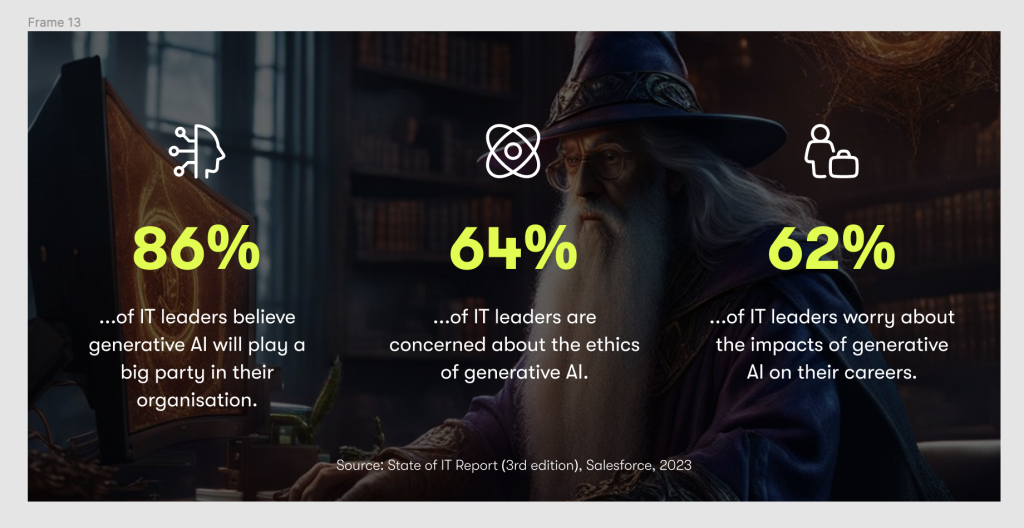Mastering the arcane art of generative AI could be the secret to accelerating your business. But wait too long and you could be left in the dark ages.
If generative AI seems like some form of arcane alchemy to you, you’re not alone.
Any new tech trend usually comes wrapped in a bunch of hype that can make the various wild promises seem like so much hocus pocus. Enter a prompt into the magic box and stuff just appears out of nowhere — incredible artwork, engaging copy, personalised customer responses, even workable code. (Imagine, computers writing their own apps!)
And this year, generative AI certainly hit the peak of its hype curve.
As Arthur C. Clark famously wrote: “Any sufficiently advanced technology is indistinguishable from magic.”
But while the benefits may be obvious, many businesses still view AI with suspicion. The possibilities appear so incredible, so sci-fi, so magical. There has to be a catch.
How much can you trust it? What about some of the ethical issues to consider, such as copyright, IP and training data? Whose jobs will be replaced? Oh god… would my job be replaced?
It’s this unpredictable, “anything can happen” quality of generative AI that some people can find daunting. It all seems so risky. Safer to stay a muggle.
However, these risks (if they are risks) pale against the very real risk of your business being left behind as, one by one, your competitors start their own AI journeys.

The best way to combat the unknown is to make it knowable. So let’s start demystifying the wizardry with some basic principles.
What is generative AI?
You know what? Let’s ask the machine.
I typed “What is generative AI?” into ChatGPT and watched the words appear underneath in seconds. 359 words to be exact, which is more than I wanted to include here.
So I asked ChatGPT to hone that down to a tight 100 words or less.
“Generative AI is a subset of artificial intelligence that involves the creation of content, such as text, images, and audio, by machines. It uses models like Generative Adversarial Networks (GANs) to learn from data and generate new, original content. This technology has a wide range of applications, including text generation, image creation, audio synthesis, and data augmentation. Generative AI has made significant strides, impacting industries like entertainment, healthcare, and finance. However, it also raises ethical concerns, especially in the context of generating fake content and deepfakes, prompting increased scrutiny and regulation.”
It’s still a bit wordy and lacking in style, but the nutshell is there: Generative AI is where the machines create the content.

Say “content” and most people think text and images, perhaps audio and video. But content can mean so much more.
For example, some organisations are already using generative AI to create, analyse and optimise code — reducing bugs and streamlining development workflows. Apps and websites are content too.
But one area where generative AI is already having an impact is customer service. Those generic chatbot responses that never quite seem to answer your query? Also content. Imagine if AI could access your personal account details and generate customised, specific and genuinely helpful responses related to your problem — or even action your account-based requests without forwarding you to a customer service agent. (“Current wait time is five minutes. We value your patience.”)
Some organisations are already working on bespoke and private Large Language Models (LLMs) to do just that. And these LLMs have to be bespoke and private to keep your personal account information safe and secure.
In short, generative AI is your data entry clerk, customer support front line, researcher, code tester and marketing admin.

Not your replacement – your co-pilot
That brings us neatly to one of the biggest bogeymen that often crops up in conversations around AI. No, the machines aren’t going to replace you.
Okay, that might not strictly be true. Machines aren’t going to replace most of you. But if your job title is still Data Entry Clerk or Bank Teller in 2023, I’d be more surprised that you’ve held on this long.
For most of us, AI is helping to automate those parts of the job that, let’s be frank, probably weren’t always the best use of our time anyway. Unless you really enjoy manually crunching the numbers each month to generate your sales report.
And that’s the point. Generative AI is a way to enhance your team’s capabilities, not replace or supersede them. Used effectively, it frees up time, increases accuracy, ensures consistency, and basically allows each person to focus more of their creative energy on those tasks likely to deliver the most value or have the biggest impact.
That’s where the real magic happens. Generative AI isn’t a better, more productive you. It helps you to be a better, more productive you.
It’s okay to be a novice with this stuff. Even the early adopters are closer to the beginning of their journeys with generative AI than they are to the end. But that also means there is a steadily growing body of content and advice to light the way for the rest of us,
With diligent study, careful application and dedicated practice, you too can develop your skills until the apprentice magician becomes the master sorcerer.
Wondering about generative AI for your business but not sure where to start?
AI experts Rakz Mathur and Nick Beauguard’s book — Make AI Happen: A Guide for Business Executives — is out now.
- Improve business outcomes with AI
- Explore popular AI tools and how to use them
- Develop effective AI workflows
And when you’re ready to implement your AI-powered ideas, Pounce can run a dedicated workshop with your team to design workflows and train users.





